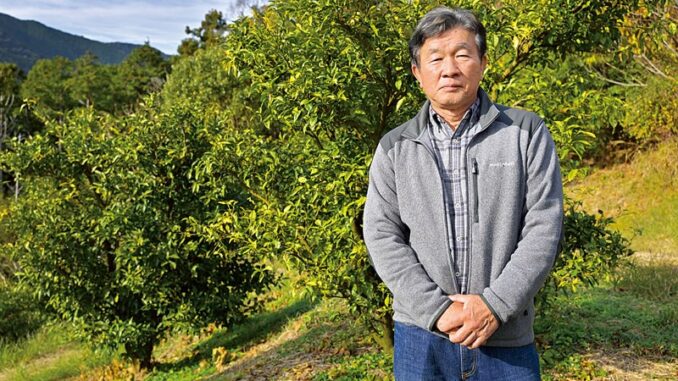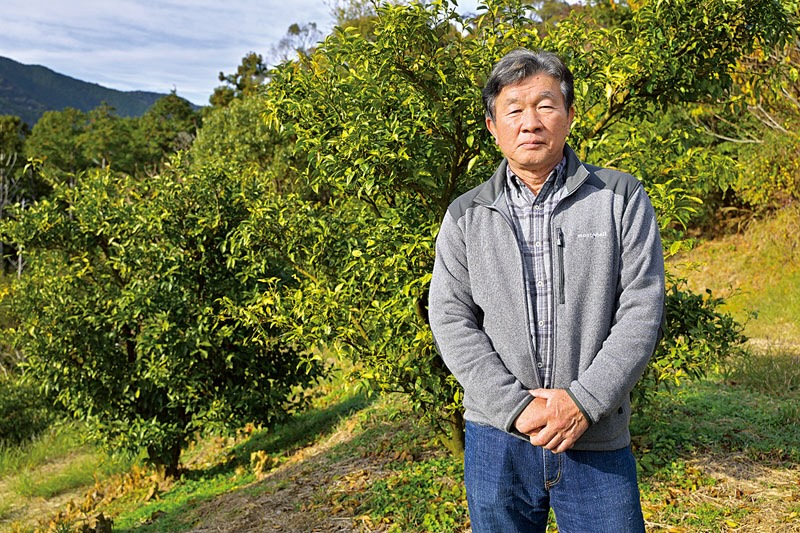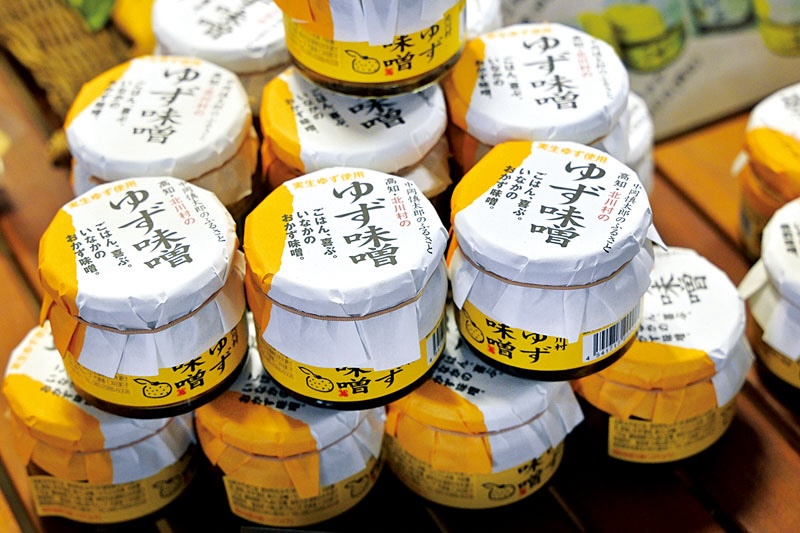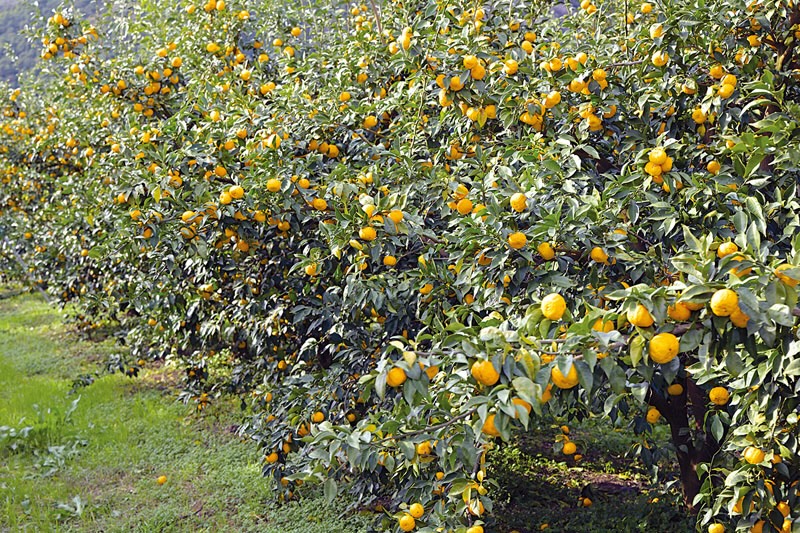

The village of Kitagawa is one of the main production centres for this increasingly popular citrus fruit.
You can’t talk about Kochi without mentioning yuzu, a beautiful citrus fruit with an amazing, strong fragrance and sour taste that is very popular in Japanese cuisine. While similar to a lemon, yuzu adds an extra special flavour whenever it’s added to a dish, from marinades and sauces to desserts. And Kochi Prefecture has the highest yuzu yield in Japan.
Yuzu is produced in South Korea, China, and recently also in Mexico and Spain, but Japan has the highest production volume in the world. Yuzu is thought to have been introduced from China to Japan in the early Heian period (9th century). However, according to some Japanese history books, it was already cultivated a couple of centuries earlier.
According to statistics from the Ministry of Agriculture, Forestry and Fisheries, yuzu was mainly farmed in Saitama Prefecture, just north of Tokyo, until the 1960s, but since 1970, Shikoku has become the country’s main production area. Today, Japan’s fourth biggest island accounts for nearly 80% of domestically produced yuzu, and Kochi, in particular, is the world’s largest producer (55% of Japan’s total harvest), rising from 3,000 tons in 1985 to 11,700 in 2020.
In Kochi, yuzu orchards are everywhere, and Kitagawa-mura’s fruits have a particularly high reputation in the market for their size, quality and aroma. Located about 60 kilometres east of Kochi Station in a hilly area with an average altitude of 412 metres, Kitagawa is a small village with a population that declining birthrate, aging and depopulation have reduced to fewer than 1,200 people. There’s only one elementary school and one junior high school. There are no trains either. Besides trusting the rapidly vanishing bus service, you need a car to visit its main tourist attraction – a reproduction of Impressionist painter Claude Monet’s famed garden – or its hot springs.
The Nahari River, which flows through the centre of the village, is a treasure trove of freshwater fish. But tiny Kitagawa also has a world-class specialty: yuzu farming. Most of the villagers are involved in yuzu cultivation, and every November the crisp cool air is filled with the scent of yuzu. The flowers bloom around May and the fruits start to appear in the latter half of the month. Harvest season is from mid-October to about the 10 December, starting when the round fruits begin to turn yellow. Ah, and Kitagawa was also the first place in Japan to export yuzu to France and other European countries.
Kitagawa has a total cultivated area of over 100 hectares divided among 13 farms. This time we pay a visit to the Tosa Kitagawa Farm, a 2.4 ha property with 1,920 yuzu trees planted on the top of a hill.
Yuzu is a cold-resistant fruit that nevertheless loves warm and rainy areas. In this respect, Kitagawa is the ideal place to grow them as it has a high annual rainfall (2,000 mm to 3,000 mm) and is affected by large temperature differences between day and night. For this reason, local yuzu grow large and juicy and have a fragrant aroma.

Tadokoro Masaya who runs the Tosa Kitagawa Farm explains that the origin of the yuzu industry dates back to the end of the Edo period. “Nakaoka Shintaro, a samurai and a close associate of Sakamoto Ryoma in the movement to overthrow the Tokugawa shogunate, was born in Kitagawa,” he says. “He was murdered in 1867 together with Sakamoto, but before his untimely death at the age of 29, he encouraged the villagers to cultivate yuzu, which had been growing naturally in that area since ancient times.”
Tosa (Kochi’s old name) was hit by earthquakes both in 1854 and 1855, and due to the ensuing recession the farmers could not buy salt, necessary to make miso and soya sauce. The son of the village headman, Nakaoka realized that yuzu could be used as a preservative and seasoning instead of salt and ideally become a new source of wealth.
The real push to turn Kitagawa into a major centre of yuzu production occurred one century later, around 1965. At that time, forestry and rice cultivation were in decline. Remembering Nakaoka’s words, the local farmers turned to yuzu as the region’s main product. “When you grow yuzu from seed, it takes a considerable amount of time before ready to harvest,” Tadokoro says. “So-called seedling yuzu bear fruit after ten years at the earliest, and up to 20 years if conditions are bad. However, around 1965, a cultivation method using grafting was adopted, which significantly shortened the time until harvest.” Grafting is a technique whereby tissues of different plants are joined so they continue their growth together. Using this method, a tree is able to bear fruit in just 4 to 5 years.
“Currently, most yuzu trees are grown by grafting,” Tadokoro says, “but in Kitagawa Village there are still many old seedling yuzu trees that are said to date back to Nakaoka’s times. Vinegar and other products made with seedling yuzu have a stronger flavour and aroma and, according to a researcher at Kochi University, they contain more organic acids and aromatic components such as limonene.”
In 1965, Kitagawa farmers began to expand their yuzu growing operations by planting 7,300 yuzu trees in a 6.5-ha plot of land, and ten years later, yuzu farmland had expanded to 100 hectares. In the same period, the Kitagawa Village Agricultural Cooperative purchased a large juice extraction machine and automatic bottling machine. They were replaced by a brand-new processing facility in 2009.
Even ripe yuzu has a very sour taste, so it’s not normally eaten as it is. Instead, it’s mainly used as a seasoning as its juice and peel add flavour and sourness to many Japanese dishes. The most popular yuzu-based product is ponzu, a sauce commonly used in Japanese cuisine. It is traditionally used as a dressing for tataki (lightly grilled, then chopped meat or fish) and also as a dip for nabemono (one-pot dishes) such as shabu-shabu (meat and vegetable hotpot) and some kinds of sashimi.
Another popular product, yuzu kosho (chilli paste), is made with green chilli peppers. “The peppers we use are grown both at our place and contracted farms,” Tadokoro says. “We’re particular about pesticide-free cultivation and take a lot of time and effort to grow them. Our employees work together to harvest the chilli peppers before they turn red.”
Yuzu is also one of the seven ingredients of shichimi (a kind of chilli pepper spice mix) and can be added to various alcoholic drinks such as sake and shochu (a distilled beverage), while the best-known food (at least in Japan) containing yuzu is yubeshi, a type of traditional Japanese confectionery.
“Last but not least, for the past several years, yuzu has been used for cosmetics,” Tadokoro says. Indeed, for a long time, yuzu extract has been used as a scent in fragrance and bath products. However, the use of yuzu jumped almost 100% in 2008 in both skincare and makeup, and today, yuzu peel extract and yuzu oil are increasingly included for their naturally energizing, toning and brightening properties.
For the last ten years or so, many Western chefs have also added yuzu as a new exciting flavour to their cooking arsenal. The growing interest of the gourmet world has been the key to entering foreign markets. “In 2009 our harvest was exceptionally big,” Tadokoro says. “Our harvest increased from the usual 800 tons to 2,100 tons, and the agricultural cooperative could not handle all the yuzu it bought from us, causing the unit price to drop rapidly. Though this difficult period continued for three to four years, the prefecture acted immediately to find an alternative market outside Japan. The interesting thing is that, eventually, the reputation we gained overseas also served as an opportunity to improve the branding and marketing of yuzu in Japan.”
“To start with, we took part in in the Singapore Food Exhibition in 2010,” says Matsumoto Risa from the Industrial Policy Division of Kitagawa Village Hall. “Then, the following year, we held a yuzu tasting event at a two-star restaurant in Paris, France. Local restaurant and pastry chefs participated, and everybody was captivated by yuzu’s aroma, which is different from lemons and oranges. After that event, we received a request for a shipment of whole, raw yuzu. That’s how our exports to the EU got started.”
This, however, was just the beginning of a long process. In September 2012, Kitagawa Village organized a yuzu tasting event to which they invited the president of a French import company, a famous French chef, and a world-champion pastry chef from Spain. In October of the same year, they flew to France again, this time to present their fruits at SIAL, Europe’s largest food trade fair. Along the way, they had to overcome several obstacles: they had to build a dedicated farm in order to meet the EU’s strict cultivation conditions for pesticides, and in order to abide by Europe’s trade regulations, they urged the national government to improve export conditions. Finally, after much trial and error, Kitagawa’s first yuzu fruits were shipped via airmail to France in November 2012.
Kitagawa’s success in Europe has been the stimulus to expand its international business to other continents. In 2019, for instance, they were in Dubai to exhibit at Gulfood, the largest annual food trade fair in the world. They currently export both yuzu juice (30-40 tons a year) and whole yuzu (about 4 tons) to 19 countries worldwide. “France and the United States are the number-one yuzu importing countries,” Matsumoto says, “but our sales are also growing in Asia, in places like Singapore and Dubai.”

Asked about yuzu’s recent popularity, Tadokoro guesses that taste and aroma aside, it may appeal to health-conscious people. “Yuzu contains the highest amount of vitamin C and citric acid among fruits,” he says. “Vitamin C is a type of water-soluble vitamin that has an antioxidant effect and is a nutrient necessary for the production of collagen, which repairs cell damage caused by stress and also helps support our immune system. Citric acid helps recovery from fatigue and is good for your metabolism. In addition, yuzu peel contains many aromatic components such as limonene as well as essential oil components, which have relaxing effects, stimulate the sympathetic nervous system and improve blood flow.”
Among the current yuzu farmers in Kitagawa, Tadokoro is one of the veterans. He used to work in the construction industry until he opted for a quieter, more natural and relaxing life. “Now, every day is fun,” he says. “Above all, I have time for myself and get to know all kinds of people. Yuzu is my communication tool.”
Tadokoro might always speak with a gentle smile, but he’s acutely aware of the changing times and the challenges the yuzu industry in Kitagawa is facing. “I don’t know whether it’s to do with global warming,” he says, “but I’ve noticed a few subtle changes. My yuzu, for example, are turning yellow a little faster than ten years ago. Also, pests have increased tremendously. Over the past three or four years, rainfall has become somewhat haphazard: there are months when there’s little or no rain at all, and times when it rains too much.”
Currently, the majority of yuzu farmers are mainly second-generation producers who’ve inherited the spirit of the Showa era (1950s and ‘60s) from their fathers. “Tradition is important, but it can’t be preserved unless it evolves,” Tadokoro says. “One of the more important recent developments is what’s become known as the Kitagawa Project, which aims to develop and preserve yuzu farmland. Since many of the current farmers are getting old, we’re encouraging young people to move here and take up the work. However, the problem is that Kitagawa is a steep, hilly area, so it’s difficult to find new flat farmland. As part of our efforts to attract people here, we asked the government for help. Up until now, there had been no national project to improve farmland in such regions as Kitagawa Village, but after trying many times to engage with the authorities, the government finally responded to our requests and the Ministry of Agriculture helped us develop new farmland. Now, Kitagawa’s total farmland is about 100 hectares, of which about 10 hectares were created through this project.”
Tadokoro says that their success in branding local yuzu and expanding their sales beyond the Japanese border has been a wonderful surprise, but has also made them aware that they need new blood to keep things going as they are now. “We need to secure people who want to get involved in yuzu production,” he says. “JA and the government are taking care of overseas sales channels, so we don’t have to worry too much about that side of our business. If anything, the supply is not keeping up with increasing demand, so we need to attract more people to our village.
“Kitagawa’s support system for yuzu farmers is the best in the country, and there’s no doubt that it’s the best village in Japan to start growing yuzu. The village buys farmland, maintains it and then rents it out. This is the most generous support system you can ask for. In this respect, I’d say that Kitagawa Village is pretty unique.
“I like our small community. We all get along well, and producers work together to learn from each other and improve their skills. In the same way, we also make sure to pass on our skills and knowledge to young members and other people who decide to move here, improve yuzu cultivation and contribute to maintaining our old traditions. All in all, it’s a nice way to secure an income while enjoying working outdoors and doing a job that allows you to take time off.”
Jean Derome
To learn more on this topic , check out our other articles :
N°138 [FOCUS] Battling to attract people
N°138 [NEWS] A tribute to local newspapers
N°138 [TRAVEL] A wealth f beauty
N°138 [CULTURE] For the love of nature
Follow us !



